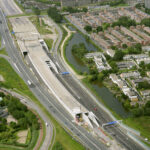
Adaptive Flow Management keeps traffic moving safely in tunnels
The Maastunnel in the Dutch city of Rotterdam has been reopened after major renovation works that lasted two years. The tunnel once again meets all of the most modern safety requirements. The ventilation method used in the Maastunnel entails specific demands on traffic flow. The Adaptive Flow Management system has been designed to keep traffic in the tunnel moving.
Minimum speed
Since the Maastunnel is a national monument, no visible ventilators could be placed at the entrances. Instead, longitudinal ventilation had to be used: air is fanned through the tunnel at a speed of 15 km/h. This means that traffic must at all times maintain the same speed to prevent it from being overtaken by smoke or dangerous gases during a calamity. Ensuring the flow of traffic is the Adaptive Flow Management (AFM) system’s most important task.
Regulating traffic lights
In order to achieve this flow, AFM permanently regulates the traffic lights in the wide surroundings of the tunnel. In this way, traffic is spread across a large part of the urban network, from the A20 in the north to the A15 in the south. Whenever congestion threatens to occur in the tunnel, AFM reduces green time on the access roads, thus relieving pressure on the tunnel.
The new Maastunnel has to comply with all safety regulations, and AFM provides active support to achieve this. Traffic lights downstream from the tunnel can cause tailbacks: traffic jams that are so long that vehicles end up queueing in the tunnel itself. To prevent this, AFM increases green time for traffic lights downstream from the tunnel. Moreover, AFM permanently monitors the level of traffic in the tunnel. By increasing outflow and, if necessary, limiting inflow, the system ensures that there is always enough room downstream from the tunnel to be able to evacuate vehicles in case of a calamity.
Proven technology
AFM works fully autonomously. A separate tunnel management system (TMS) monitors tunnel safety. AFM warns the TMS if traffic flow falls below safe standards. The TMS and the tunnel operator can then decide if and how to intervene. In addition, AFM also offers assistance during certain specific situations, such as lane closures and the passage of emergency vehicles, supporting interventions by the tunnel operator.
This is the first time that any similar system for safety and traffic management has been used in a tunnel. The AFM’s unique approach proved its merits in the Praktijkproef Amsterdam (PPA), which improved flow on the A10 near Amsterdam. The technique has also been used succesfully for flow management on the redesigned ’t Goylaan in Utrecht, and for flow improvement works on the A12 parallel lanes south of Utrecht. The system can be connected with a traffic management system through DVM-Exchange.
Partners
AFM was developed by TNL together with the City of Rotterdam, Arane Consultancy and traffic data specialist Fileradar.


